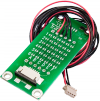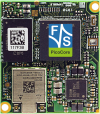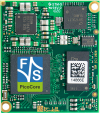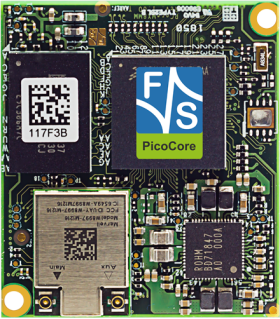PicoCore™MX8MM-V4-LIN
Computer On Module with NXP i.MX 8M Mini CPU
|
|
For the start of development, we recommend The PicoCore™MX8MM is mentioned in the February issue of Computer&Automation. Read the article (German only) on page 21. The digital magazine Elektroniknet also reports on the PicoCore™MX8MM. Read the article here (German only). |
| PicoCore™MX8MM-V4-LIN | ||
| State | Production | |
| CPU | ||
| CPU | NXP i.MX 8M Mini | |
| Core | ARM Cortex-A53 Cortex-M4 |
|
| No of Cores | 4x A53 + 1x M4 | |
| Frequency | 1.8GHz + 400MHz | |
| L2-Cache | 512KB | |
| GPU | 2D GC328, 3D GCNanoUltra (1 shader) | |
| VPU | Decode: 1080p60 HEVC/H.265, H.264, VP9, VP8 Encode: 1080p60 H.264, VP8 |
|
| Security | ||
| Operating System | ||
| Linux | Buildroot/ Yocto (uboot installed) |
|
| Real Time | FreeRTOS | |
| Memory | ||
| eMMC | 4GB | |
| RAM | 1GB LPDDR4 | |
| Interfaces | ||
| SD-Card | 1x SDIO | |
| Ethernet | 1x 100/1000Mb | |
| WiFi | 802.11 ac/a/b/g/n (2.4/ 5GHz) |
|
| BT | 5.3 | |
| USB Host | 1x | |
| USB Device | 1x OTG 2.0 | |
| UART | max. 4x | |
| I2C | max. 4x | |
| SPI | max. 2x | |
| Audio | Line In/ Out/ Mic/ Headphone | |
| Digital I/O | ✓ | |
| Touch Panel | via I2C or USB | |
| Camera | MIPI CSI | |
| PCIe | 1x | |
| RTC | PCF85263ATL | |
| More | max. 4x PWM, Watchdog, SPDIF, ESAI, SAI, SSI |
|
| Display | ||
| LVDS | 2x 24bit | |
| Common | ||
| V_IN | +4.5V - 5.5VDC | |
| T_AMB | 0°C - +70°C | |
| Size | 35x40mm | |
| Availability | 2034+ |
 |
Starterkit PicoCore™MX8MM Linux PicoCore™MX8MM-V14I-LIN, base board, 7" LVDS display, cable kit, access data for documentation and software SKU: PCoreMX8MM-SKIT2 |
360,- € |
Software
 |
Secure Boot as a Service The SBS (Secure Boot as a Service) includes the signing (protection against manipulation) and if necessary encryption (protection of intellectual property) by F&S Elektronik Systeme. SKU: Linux-SBS |
500,- € | ||
 |
Display Customization (RGB or LVDS display under Linux) Creation of a DeviceTree (Buildroot or Yocto) for your F&S Board. The DeviceTree contains the appropriate entries for your display. SKU: EW-SW |
700,- € | ||
 |
Display Customization (MIPI-DSI Display under Linux) Creation of a DeviceTree / kernel (Buildroot or Yocto) for your F&S Board. The DeviceTree / kernel contains the appropriate entries for your MIPI-DSI display. SKU: EW-SW-MIPI-DSI-Linux |
1,000,- € |
Displays
 |
3.5" MIPI-DSI Display with PCAP Touch (long-term available) 3.5" TFT (640x480) MIPI-DSI Display with PCAP Touch (TFT-3.5"-MIPI-DSI-PCAP Touch) SKU: B.LCD.22 |
65,- € | ||
 |
7” LVDS Display with PCAP Touch (long-term available) 7” LVDS LCD Display with PCAP Touch SKU: LCD.7.LVDS.1 |
89,- € | ||
 |
10” LVDS Display with PCAP Touch (long-term available) 10” LVDS LCD Display with PCAP Touch SKU: LCD.10.LVDS.1 |
130,- € |
Touch Kits
 |
Resistive Touch Kit For connecting a resistive Touch panel to F&S boards with 4-poles touch connector. SKU: SINTF-ADP-RESTOUCH |
35,- € | ||
 |
Resistive Touch Kit 2 For the connection of a resistive touch panel to boards with 6pol Hirose socket. SKU: SINTF-ADP-RTI2C |
Request | ||
Cables
| Backlight Cable Backlight cable for connecting the 7"/10" LVDS displays (LCD.7.LVDS.1 and LCD.10.LVDS.1). SKU: B.MKAB.35 |
7,- € | |||
 |
LVDS/MIPI Adapter Cable LVDS/MIPI cable with two 30pin connectors each (JAE X30HL-B to JAE X30HL-B) SKU: B.MKAB.44 |
22,- € | ||
 |
30poles Film Cable Film cable, 30pol., 0,5mm, l=100mm for displays To connect our B.LCD.22 display via ADP-MIPI2MIPI1 SKU: B.MKAB.55 |
10,- € |
Adapters
| MIPI-DSI to LVDS Adapter Allows the connection of an LVDS display to a starter kit with a 30-pin MIPI-DSI (display) socket. SKU: ADP-MIPI2LVDS1 |
25,- € | |||
 |
Adapter board MIPI-DSI (JILI30) to RGB for EDT Unified Series Enables conversion of MIPI-DSI (JILI30) to RGB signals. SKU: ADP-MIPI2RGB1 |
30,- € | ||
 |
MIPI-DSI (FFC) to MIPI-DSI (JILI30) Adapter Enables the conversion of 30pol FFC connections of the 3.5" MIPI Display from F&S to JILI30 (JAE X30HL-B). SKU: ADP-MIPI2MIPI1 |
25,- € |
Plug Connector
 |
PicoCore™ 100 pins Connector To connect PicoCore™ modules to the base board (20 pcs). SKU: B.MBU.2R100PS.3 |
30,- € |
Workshops
 |
Workshops Workshops for F&S Boards with Windows Embedded Compact or Linux - Beginner Workshops - Qt 5 - Asymmetric Multiprocessing - Secure Boot SKU: NDCU-WS1 |
Request | ||
 |
Secure Boot as a Package Secure Boot as a Package contains a workshop, where you learn how to realize the topic Secure Boot. You will also receive a user Tool Software. SKU: WS-SBP |
500,- € | ||
Other Accessories
 |
Heat Spreader PicoCore100 Heat spreader for cooling PicoCore boards. SKU: MHS.PC100.1 |
10,- € | ||
 |
SMD Steel Spacer for PicoCore™ Round SMD steel spacer/ Round Standoff Threaded M2x0.4 Steel 0.059" (1.50mm) Helps you to connect your PicoCore module to the base board. SKU: B.MSCHR.22 |
70,- € | ||
 |
Patch Antenna Patch antenna for WLAN/BT (2.4/ 5 GHz) for connection to F&S boards with WLAN/BT antenna socket. SKU: B.ANT.6 |
3,- € | ||
 |
USB Stick USB Memory Stick with memory size (2GB+) and imprinted F&S logo. The USB Stick was tested on all current F&S boards. SKU: USBSTICK.1 |
20,- € |
Variants
 |
PicoCore™MX8MM-V1-LIN NXP i.MX 8M Mini ARM Cortex-A53 + Cortex-M4, 1GB LPDDR4 RAM, 4GB eMMC, RGMII Ethernet, Audio, MIPI-CSI Camera, Touch, MIPI-DSI, 0°C - +70°C, Linux Buildroot/ Yocto, FreeRTOS SKU: PCoreMX8MM-V1-LIN |
Request | ||
 |
PicoCore™MX8MM-V2-LIN NXP i.MX 8M Mini ARM Cortex-A53 + Cortex-M4, 1GB LPDDR4 RAM, 4GB eMMC, Gb Ethernet, Audio, MIPI-CSI Camera, Touch, LVDS, 0°C - +70°C, 3.8V Supply, Linux Buildroot/ Yocto, FreeRTOS SKU: PCore8MMr2-V2-LIN |
Request | ||
 |
PicoCore™MX8MM-V3-LIN NXP i.MX 8M Mini ARM Cortex-A53 + Cortex-M4, 1GB RAM, 512MB Flash, Gigabit Ethernet, Audio, WLAN, BT, PCIe, MIPI-CSI Camera, Touch, LVDS, 0°C - +70°C, 3.8V Supply, Linux Buildroot/ Yocto, FreeRTOS SKU: PCoreMX8MM-V3-LIN |
Request | ||
 |
PicoCore™MX8MM-V4-LIN NXP i.MX 8M Mini ARM Cortex-A53 + Cortex-M4, 1GB RAM, 4GB eMMC, Gigabit Ethernet, Audio, WLAN, BT, PCIe, MIPI-CSI Camera, Touch, LVDS, 0°C - +70°C, 3.8V Supply, Linux Buildroot/ Yocto, FreeRTOS SKU: PCoreMX8MM-V4-LIN |
Request | ||
 |
PicoCore™MX8MM-V5-LIN NXP i.MX 8M Mini ARM Cortex-A53 + Cortex-M4, 512MB RAM, 256MB Flash, 2x Gigabit Ethernet, Audio, MIPI-CSI Camera, Touch, 2x LVDS, 0°C - +70°C, 3.8V Supply, Linux Buildroot/ Yocto, FreeRTOS SKU: PCoreMX8MM-V5-LIN |
Request | ||
 |
PicoCore™MX8MM-V6-LIN NXP i.MX 8M Mini ARM Cortex-A53 + Cortex-M4, 512MB RAM, 256MB Flash, 2k Bit EEPROM, 2x Gigabit Ethernet, Audio, MIPI-CSI camera, Touch, 4-lanes MIPI-DSI, 0°C - +70°C, 3.8V supply, Linux Buildroot/ Yocto, FreeRTOS SKU: PCoreMX8MM-V6-LIN |
Request | ||
 |
PicoCore™MX8MM-V14I-LIN NXP i.MX 8M Mini ARM Quad Cortex-A53 + Cortex-M4, 2GB RAM, 16GB eMMC, Gigabit Ethernet, Audio Codec, WLAN, BT, PCIe, MIPI-CSI, LVDS, CAN, SE050, QSPI, RTC, -25°C - +85°C, Linux, FreeRTOS SKU: PCore8MMr2-V14I-LI |
Request | ||
 |
PicoCore™MX8MM-V21I-LIN NXP i.MX 8M Mini ARM Quad Cortex-A53 + Cortex-M4, 8GB RAM, 32GB eMMC, Gigabit Ethernet, Audio Codec, WLAN, BT, PCIe, MIPI-CSI, LVDS, CAN, SE050, -25°C - +85°C, Linux, FreeRTOS SKU: PCore8MMr2-V21I-LI |
Request | ||
 |
PicoCore™MX8MM-V19-LIN NXP i.MX 8M Mini ARM Quad Cortex-A53 + Cortex-M4, 4GB RAM, 32GB eMMC, Gigabit Ethernet, Audio Codec, WLAN, BT, PCIe, MIPI-CSI, LVDS, CAN, SE050, 0°C - +70°C, Linux, FreeRTOS SKU: Pcore8MMr2-V19-LIN |
Request | ||
 |
PicoCore™MX8MM-V13-LIN NXP i.MX 8M Mini ARM Cortex-A53 + Cortex-M4, 1GB LPDDR4 RAM, 4GB eMMC, 1x GBit LAN, Audio, MIPI-CSI Kamera, Touch, MIPI-DSI,WLAN/BT, 0°C - +70°C, 3.8V Versorgung, Linux Buildroot/ Yocto, FreeRTOS SKU: PCore8MMr2-V13-LIN |
Request | ||
Starterkits
 |
Starterkit PicoCore™MX8MM Linux PicoCore™MX8MM-V14I-LIN, base board, 7" LVDS display, cable kit, access data for documentation and software SKU: PCoreMX8MM-SKIT2 |
360,- € |
Software
| Architecture | Type | Release Name | Bootloader | Kernel | OS | Help File | Software | VM |
|---|---|---|---|---|---|---|---|---|
| FSIMX8MM | Buildroot | fsimx8mm-B2023.11 | U-Boot 2021.04 | Linux 5.15.131 | Buildroot 2023.02.06 | |||
| FSIMX8MM | FreeRTOS | fsimx8mm-V2021.07 | sdk-2.9.1 |
|
||||
| FSIMX8MM | Yocto | osm8mm-Y2024.10.1 | U-Boot 2021.04 | Linux 5.15.160 | Yocto 4.0.20 Kirkstone | |||
| FSIMX8MM | Yocto | fsimx8mm-Y2023.10 | U-Boot 2021.04 | Linux 5.15.131 | Yocto 4.0 Kirkstone |
Buildroot and Yocto
For i.MX8M Mini, F&S has adapted Yocto as well as Buildroot. In addition, F&S provide a BSP for FreeRTOS. This FreeRTOS BSP makes it easier to use features of Cortex-M4.
The Buildroot BSP is a software for creating root file systems. About 1400 different software packages can be added to the root file system using menu control. The range of functions ranges from simple libraries and utilities to a complete Java environment to complete graphical environments such as Qt, Wayland/Weston or X11, including applications such as an HTML5-capable web browser. In this way, it is very easy to put together a customized Linux system.
Yocto has established itself as the standard for Linux build environments in recent years. Our standard configuration, which is intended to give a first impression of the module's functionality, includes the following features: Busybox, gdb, alsa-utils, gstreamer, fbv, X11R7, matchbox, feh, openssl, openssh, ncurses, can-utils, iproute2, ftpd, httpd, telnet, tftp, and much more.
F&S also offers a virtual machine (based on VirtualBox) with an installed Linux based on the Fedora distribution for free download. All packages necessary to translate our software are already installed. All services (NFS, TFTP) for working with our boards are also installed. Our BSP is unpacked and precompiled in the right directories. With this virtual machine it doesn't matter whether you use Windows or Linux as the host. Simply download the VHD, import it into VirtualBox and development can begin immediately.
FreeRTOS
In addition to the 4 Cortex-A53 cores, the NXP i.MX8M Mini CPU also has a Cortex-M4 core. The Cortex-M4 core is particularly suitable for real-time tasks or for power saving.
F&S offers a completely tested BSP for the use of the Cortex-M4 for FreeRTOS or Bare Metal application.
PicoCoreMX8MM - Product Flyer
- English (567 KB, pdf) - 23/06/2025
- Customer Specific Boards (93 KB, pdf) - 20/09/2017
Usage
By downloading you accept our general terms and conditions.
Usage
By downloading you accept our general terms and conditions.
PicoCoreMX8MM - Linux
- PicoCoreMX8MM Linux First Steps (1.1 MB, pdf) - 07/10/2024
- Linux on F&S Boards (2.9 MB, pdf) - 20/12/2023
- GPIO Reference Card for PicoCoreMX8MM-V3-V4 (597 KB, pdf) - 28/04/2021
- GPIO Reference Card for PicoCoreMX8MM-V5-V6 (592 KB, pdf) - 28/04/2021
- Quickstart with FS Development Machine (1 MB, pdf) - 06/05/2020
- Application Development with Eclipse (2.4 MB, pdf) - 18/10/2022
- Application Development with Crank (485 KB, pdf) - 28/07/2022
- Application Development with QT (2.1 MB, pdf) - 29/07/2025
- Steps Required For Creating A Progress Bar In Linux (473 KB, pdf) - 12/07/2019
- Advice for Linux on PC (2 MB, pdf) - 10/01/2018
- How to Write SD Card Image (121 KB, pdf) - 29/03/2021
- DOTNET on F&S Boards (1.1 MB, pdf) - 19/06/2024
- Visual Studio Code C/C++ Application Development (455 KB, pdf) - 29/05/2024
- F&S Support Forum - (external link)
Usage
By downloading you accept our general terms and conditions.
Usage
By downloading you accept our general terms and conditions.
Usage
By downloading you accept our general terms and conditions.
Usage
By downloading you accept our general terms and conditions.
Usage
By downloading you accept our general terms and conditions.
Usage
By downloading you accept our general terms and conditions.
Usage
By downloading you accept our general terms and conditions.
Usage
By downloading you accept our general terms and conditions.
Usage
By downloading you accept our general terms and conditions.
Usage
By downloading you accept our general terms and conditions.
Usage
By downloading you accept our general terms and conditions.
Usage
By downloading you accept our general terms and conditions.
Usage
By downloading you accept our general terms and conditions.
PicoCoreMX8MM - Hardware
- Hardware Documentation for PicoCoreMX8MM with LPDDR4 (1.2 MB, pdf) - 19/06/2024
- Hardware Documentation for PicoCoreMX8MM with DDR3L (1007 KB, pdf) - 15/11/2021
- 3D Step Model PicoCoreMX8MM-LPDDR4 HW Rev 130 (1.7 MB, zip) - 09/07/2024
- 3D Step Model PicoCoreMX8MMr2-LPDDR4 HW Rev 100 (1.6 MB, zip) - 09/07/2024
- 3D Step Model PicoCoreMX8MM-DDR3L HW Rev 120 (1.9 MB, zip) - 09/07/2024
Usage
By downloading you accept our general terms and conditions.
Usage
By downloading you accept our general terms and conditions.
Usage
By downloading you accept our general terms and conditions.
Usage
By downloading you accept our general terms and conditions.
Usage
By downloading you accept our general terms and conditions.
PicoCore Carrier Board DSI/LVDS from Rev 1.50
- Carrier board PCoreBBDSI Hardware Documentation (703 KB, pdf) - 26/06/2025
- Carrier board PCoreBBDSI Schematic (2.9 MB, pdf) - 27/03/2025
- Carrier board PCoreBBDSI Design Files (17 MB, zip) - 28/03/2025
- Carrier board PCoreBBDSI Gerber Files (798 KB, zip) - 28/03/2025
- Carrier board PCoreBBDSI 3D Files (20 MB, zip) - 21/05/2025
- Carrier board PCoreBBDSI Placement (5.6 MB, pdf) - 28/03/2025
Usage
By downloading you accept our general terms and conditions.
Usage
By downloading you accept our general terms and conditions.
Usage
By downloading you accept our general terms and conditions.
Usage
By downloading you accept our general terms and conditions.
Usage
By downloading you accept our general terms and conditions.
Usage
By downloading you accept our general terms and conditions.
PicoCore Carrier Board DSI/LVDS Rev 1.10 to 1.40
- Carrier board PCoreBBDSI Hardware Documentation Rev 110 to 140 (879 KB, pdf) - 20/05/2025
- Carrier board PCoreBBDSI Schematic Rev 110 to 140 (2.9 MB, pdf) - 20/06/2024
- Carrier board PCoreBBDSI Design Files (14 MB, zip) - 25/09/2024
- Carrier board PCoreBBDSI Gerber Files (772 KB, zip) - 09/09/2021
- Carrier board PCoreBBDSI 3D Files (21 MB, zip) - 15/12/2021
- Carrier board PCoreBBDSI Placement (5.7 MB, pdf) - 09/09/2021
Usage
By downloading you accept our general terms and conditions.
Usage
By downloading you accept our general terms and conditions.
Usage
By downloading you accept our general terms and conditions.
Usage
By downloading you accept our general terms and conditions.
Usage
By downloading you accept our general terms and conditions.
Usage
By downloading you accept our general terms and conditions.
Link to the Forum
You can find support at any time in our Forum.
Recent Contributions
|
02 Dec, 09:23 |
From which linux kernel was fsimx6-B2024.04.tar.bz2 forked |
|
20 Nov, 15:40 |
Porting of unblank_delay devicetree setting to "i.MX6 Linux Release B2020.04 (Buildroot)"., Physical background |
|
20 Nov, 14:25 |
New F&S Development Machine - Fedora40 |
|
18 Nov, 12:04 |
F&S i.MX8ULP Yocto Release 2025.11 (fsimx8ulp-Y2025.11) |
|
18 Nov, 09:56 |
Windows CE 6.0 Performance Manager |
|
14 Nov, 15:27 |
Using non-volatile memory on the M33 core without the A35 core |
|
07 Nov, 09:22 |
EMC Problem on armstoneA9r2 @250Mhz |
|
04 Nov, 12:17 |
Creating a SBOM in Yocto |
|
30 Oct, 11:08 |
Set GPIO right after boot up |
|
30 Oct, 09:52 |
pin assignments for UART_B, UART_C and UART_D |
| Computer on Module | with NXP i.MX 8M Mini | |
|---|---|---|
|
This member of the new and compact PicoCore™ Computer On Module product family is offered with NXP i.MX 8M Mini CPU. Heterogeneous Multi-Core Processor ConceptThe i.MX 8M Mini is NXP's first embedded heterogeneous multi-core applications processor. It brings together high-performance computing, power efficiency, enhanced system reliability and embedded security needed to drive the growth of fast-growing edge node computing, streaming multimedia, and machine learning applications. The heart of the processor is a scalable core complex with up to four ARM® Cortex®-A53 cores with up to 2GHz, plus one Cortex®-M4 for real-time processing with 400+ MHz. The i.MX 8M Mini also packs-in hardware 1080p video acceleration to enable two-way video applications, 2D and 3D graphics to provide a rich visual HMI experience, ➜ more information on the NXP i.MX 8M Mini applications processor Long Term Availability up to 2034Another feature is the long-term availability up to minimum 2034. |
Equipment and InterfacesPicoCore™MX8MM comes with sufficient memory (RAM, SLC NAND Flash, eMMC Flash). The module offers many interfaces on its 2x 100 poles plug connectors. Part of the interfaces is specified per default (Interfaces-FIX), they are available on other PicoCore™ modules as far as possible. The Interfaces-FIX are 2x Serial (for debugging), 2x Ethernet, 1x USB Host, 1x USB Device, 1x CAN, 1x I²C (for the connection of external touch controllers) and analog audio signals (Line In/ Out/ Mic/ HP). Due to the multiple assignment of the CPU's signal lines with various interfaces, one has the possibility to choose from the interfaces through registry entries. This part is called Interfaces-FLEX. A list of all possible interfaces and their pin assignment on the plug connector can be found in the hardware specification. Please notice that not all available interfaces can be used simultaneously. A MIPI-DSI interface with up to four lanes or a 24bit LVDS interface (up to FullHD) is available for display connection. Operating SystemLinux was customized for PicoCore™MX8MM. The operating systems support all interfaces, guaranteeing an easy software development without a deeper understanding of hardware. |






